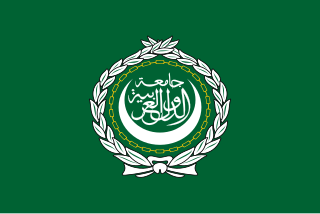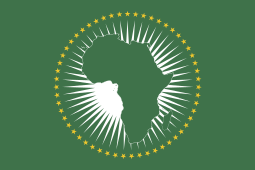
The Organisation of African Unity was an intergovernmental organization established on 25 May 1963 in Addis Ababa, Ethiopia, with 33 signatory governments. One of the main heads for OAU's establishment was Kwame Nkrumah of Ghana. It was disbanded on 9 July 2002 by its last chairman, South African President Thabo Mbeki, and replaced by the African Union (AU). Some of the key aims of the OAU were to encourage political and economic integration among member states, and to eradicate colonialism and neo-colonialism from the African continent.

The national flag of Burkina Faso is formed by two equal horizontal bands of red (top) and green, with a yellow five-pointed star resting in the center. The flag was adopted on 4 August 1984. The flag uses the Pan-African colours of Ethiopia, reflecting both a break with the country's colonial past and its unity with other African ex-colonies. The red is also said to symbolize the revolution and the green the abundance of agricultural and natural riches. The yellow star placed over the red and green stripes represents the guiding light of the revolution. The flag was adopted following the coup of 1983 which brought Thomas Sankara to power.

The flag of Bosnia and Herzegovina contains a medium blue field with a yellow right triangle separating said field, and there are seven full five-pointed white stars and two half stars top and bottom along the hypotenuse of the triangle.

The national flag of Cameroon was adopted in its present form on 20 May 1975 after Cameroon became a unitary state. It is a vertical tricolour of green, red and yellow, with a yellow five-pointed star in its center. There is a wide variation in the size of the central star, although it is always contained within the inside stripe.

The flag of the Central African Republic was officially adopted in 1958. It has been retained since that time with the same design, four horizontal stripes of blue, white, green and yellow, and a single vertical band of red, with a yellow five-pointed star in the upper left corner.

The national flag of Egypt is a tricolour consisting of the three equal horizontal red, white, and black bands of the Egyptian revolutionary flag that dates back to the 1952 Egyptian Revolution. The flag bears Egypt's national emblem, the Egyptian eagle of Saladin, centred in the white band.

The flag of Equatorial Guinea was adopted on August 21, 1979. The six stars on the flag represent Equatorial Guinea's mainland and five islands. Under the rule of dictator Francisco Nguema the flag was modified and a different national emblem was used in it. After he was deposed the original flag was restored.

The national flag of Tajikistan was adopted in November 1992, replacing the flag of the Tajik Soviet Socialist Republic of 1953. The flag features Pan-Iranian colors in a horizontal tricolor of red, white and green, with a yellow crown surmounted by an arc of seven stars at the centre. It has a width ratio of 2:3:2. The tricolor preserves the choice of colors in the former Tajik Soviet flag, as well as the 1:2 proportions.

The flag of the Arab League comprises a green banner bearing the seal of the Arab League. The twenty-two links in the chain represent the twenty-two members of the League at the time of the flag's adoption. The script gives the name of the organization: "League of Arab States".

"Let Us All Unite and Celebrate Together" is the anthem of the African Union (AU). It was written as a poem titled "Proud to be African" by Ethiopian poet Tsegaye Gabre-Medhin, while the music was composed by Kenyan choral composer Arthur Mudogo Kemoli. It had served as the anthem of the former Organisation of African Unity since 1986 before being adopted by the newly formed Union in 2002.

The emblem of the African Union features a golden, boundary-less map of Africa inside two concentric circles, with stylised palm leaves shooting up on either side of the outer circle.

The Chairperson of the African Union Commission is the head of the African Union Commission.

The African Investment Bank (AIB) is one of three financial institutions of the African Union (AU) along with the African Monetary Fund and the African Central Bank. It will be headquartered in Tripoli, Libya.

The flag of Martinique consists of a red triangle at the hoist, with two horizontal bands, the upper green and the lower black. It was adopted on 2 February 2023. The flag of France, its parent country, is also flown with official standing due to Martinique's status as a French overseas department/region. The assembly of Martinique flies a flag with the collectivity's logo on it to represent the government.

The African Union (AU) is a continental union of 55 member states located on the continent of Africa. The AU was announced in the Sirte Declaration in Sirte, Libya, on 9 September 1999, calling for the establishment of the African Union. The bloc was founded on 26 May 2001 in Addis Ababa, Ethiopia, and launched on 9 July 2002 in Durban, South Africa. The intention of the AU was to replace the Organization of African Unity (OAU), established on 25 May 1963 in Addis Ababa by 32 signatory governments; the OAU was disbanded on 9 July 2002. The most important decisions of the AU are made by the Assembly of the African Union, a semi-annual meeting of the heads of state and government of its member states.
The African Union is a geo-political entity covering the entirety of the African continent. Its origin dates back to the First Congress of Independent African States, held in Accra, Ghana, from 15 to 22 April 1958. The conference aimed at forming the Africa Day to mark the liberation movement of the African people each year, such as to free themselves from foreign dictatorship and to unite Africa. The Organisation of African Unity (OAU), was subsequently established on 25 May 1963 followed by the African Economic Community in 1981. Critics argued that the OAU in particular did little to protect the rights and liberties of African citizens from their own political leaders, often dubbing it the "Dictators' Club".

The national flag of the People's Republic of China, also known as the Five-star Red Flag, is a Chinese red field with five golden stars charged at the canton. The design features one large star, with four smaller stars in an arc set off towards the fly. It has been the national flag of China since the foundation of the People's Republic of China on 1 October 1949. The flag was designed by Zeng Liansong.

The Chairperson of the African Union is the ceremonial head of the African Union (AU) elected by the Assembly of Heads of State and Government for a one-year term. It rotates among the continent's five regions.

The flag of Cagayan is the provincial flag of Cagayan, Philippines. It is a horizontal triband of blue, gold and green, charged with the provincial coat-of-arms ringed by 29 white, five-pointed stars. It was adopted on March 11, 1970 by the virtue of Provincial Board Resolution No. 319.

Yadesa Bojia is a Seattle-based Ethiopian graphic designer and artist. Bojia has exhibited regionally since 2006. In 2010, he rose to international acclaim when his design was selected for the African Union's flag. Bojia has shown his work in exhibitions, completed commissioned works, and given public talks about the themes of his work, including human rights, minority rights, Africa, and justice. Bojia's style as a painter draws on African impressionism.

















